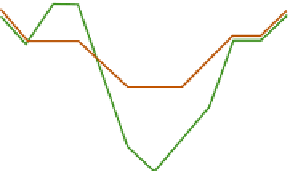Geoscience Reference
In-Depth Information
maximum was increased by 0.8°C simply by
raising the thermometer from 1.5 to 2.4m above
the forest floor. In stratified tropical forests the
thermal picture is more complex. The dense
canopy heats up considerably during the day and
quickly loses its heat at night, showing a much
greater diurnal temperature range than the
undergrowth (
Figure 12.18A
). Whereas daily
maximum temperatures of the second storey are
intermediate between those of the treetops and the
undergrowth, the nocturnal minima are higher
than either treetops or undergrowth because
the second storey is insulated by trapped air
both above and below (
Figure 12.18B
). During
dry conditions in the Amazonian rainforest,
there is a similar decoupling of the air in the
lower storey from the upper two-thirds of the
canopy, as reflected by the reduced amplitude of
diurnal temperature range. At night the pattern is
reversed: temperatures respond to radiative
cooling in the lowest two-thirds of the vegetation
canopy. Temperature variations within a layer up
to 25m in height are now decoupled from those
in the treetops and above.
°C
°F
3
(A)
4
2
Forteto oak maquis
2
1
Open
0
0
1
2
Scots pine
Norway
Spruce
2
4
3
Beech
6
4
8
5
3
(B)
4
2
Forteto oak maquis
2
1
Open
0
0
1
2
Scots pine
2
4
3
Norway
spruce
6
8
Beech
4
5
J
FM
A
M
J J
Month
A
S
O
N
D
Figure 12.17
Seasonal regimes of (A) mean monthly
temperatures and (B) mean monthly temperature ranges,
compared with those in the open, for four types of Italian
forest. Note the anomalous conditions associated with the
fortetooak scrub (maquis), which transpires little.
Source: Food and Agriculture Organization of the United Nations (1962).
D URBAN SURFACES
From a total of 6.6 billion in 2007, world
population is projected to increase to 8.2 billion
in 2025, with the proportion of urban dwellers
rising from 45 to 60 percent during the same
period. Thus, in this century the majority of the
human race will live and work in association with
urban climatic influences (see
Box 12.1
).The
construction of every house, road or factory
destroys existing microclimates and creates new
ones of great complexity that depend on the
design, density and function of the building.
Despite the internal variation of urban climatic
influences, it is possible to treat the effects of urban
structures in terms of:
36
(A)
(B)
95
34
90
32
Treetops
MAXIMA
30
85
Second storey
28
Treetops
80
26
Undergowth
Undergowth
24
75
Undergowth
Second storey
22
70
Treetops
20
MINIMA
65
18
20
24
4 8
Local time (hours)
12
16
20
J
FM
A
M
J
J
A
S
O N
D
Months
Figure 12.18
The effect of tropical rainforest stratification
on temperature.* A: Daily march of temperature (10-11 May
1936) in the treetops (24m) and in the undergrowth (0.7m)
during the wet season in primary rainforest at Shasha Reserve,
Nigeria. B: Average weekly maximum and minimum tempera-
tures in three layers of primary (Dipterocarp) forest, Mount
Maquiling, Philippine Islands.
Sources: *After Richards (1952); A: After Evans; B: After Brown.
1
modification of atmospheric composition;
2
modification of the heat budget;
3
modification of surface characteristics.




















































































